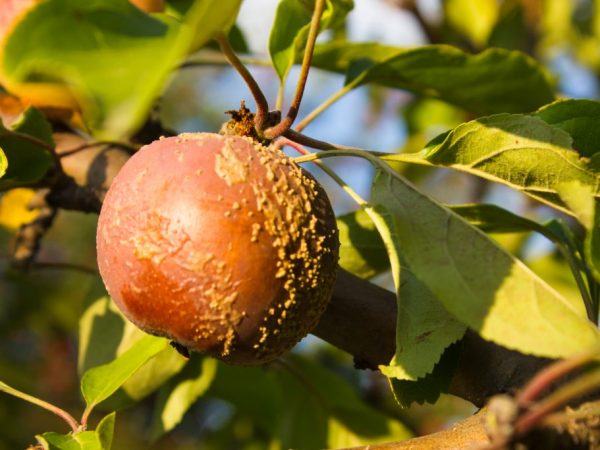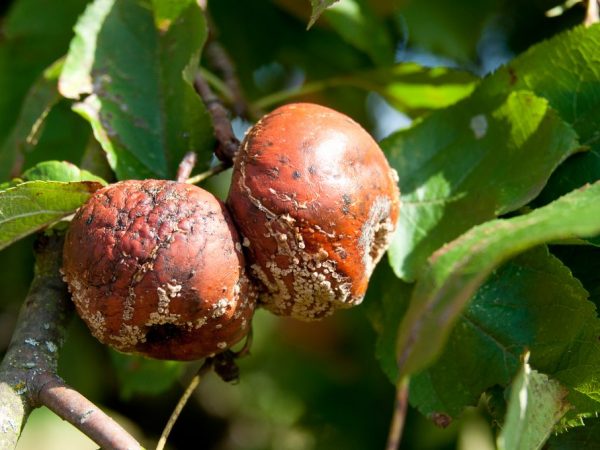How to deal with apple moniliosis
Apple moniliosis is an infectious disease with a fungal etiology. Causes damage to inflorescences, foliage, shoots and apples. It is preserved in fruits after harvest during storage, causing damage to orchards.

How to deal with apple moniliosis
Forms of moniliosis
The causative agent of fruit rot on apple trees is the ascomycete marsupial mushroom, which is widespread in regions with temperate climates, especially where the cold and wet spring season is observed. It affects apple, pear, quince, cherry, plum.
Spores are carried with wind streams or spread together with insects - moth, weevil, goose and others.
Sporulation of the fungus has the form of small white pustules - morphological elements with purulent contents. Fungal conidia are colorless, predominantly oval in shape, up to 25 microns long, collected in branching chains.
Infection of the vegetative parts of trees occurs through the penetration of the pathogen through the damage on the bark and fruits.
Life stages
The development of the fungus takes place in two stages:
- condial - by activating the sporulation process, while fungal spores, similar to small gray-yellow pads, spread throughout all vegetative parts of the apple tree;
- sclerocial - characterized by a dormant period during the wintering of fungal spores in tree bark or mummified apples.
The life cycle of the fungus coincides with the flowering and fruiting period of the tree. At the end of the winter period, conidia enter a new development cycle, initially affecting the inflorescences and shoots.
Forms
Moniliosis occurs in different forms:
- Fruit rot - apple trees are attacked through the surface of the fruit.
- Burn. Foliage, branches, inflorescences and ovaries are affected.
Often, with extensive distribution, fruit rot is transformed into young shoots, leading to the death of branches.
Reasons for the appearance

Protect apples from infections
The main peak of damage to horticultural crops occurs at the flowering stage, that is, by the second half of the summer season. Most often, the infection develops in warm and humid weather, especially with fog and dew.
The development of the fungus is favorably influenced by a long snowy winter followed by a cool long spring.
The optimum temperature for the appearance and reproduction of a fungal infection is from 15 ° C and above. The favorable factor is the increased level of humidity - 95-100%. The reason for the active growth of fungal conidia is an increase in temperature up to 20 ° C.
Other reasons:
- close contact of patients with healthy;
- low immunity of apple trees due to the presence of other bacterial, viral or fungal diseases;
- low resistance of the variety to the fungal pathogen;
- ignoring preventive measures of agricultural technology;
- poor quality of antifungal treatment of horticultural crops in spring and summer and storage sites for crops in autumn.
External signs
Signs of damage to apple trees by fungal moniliosis appear after the incubation period (for fruit rot 5-6 days, for the appearance of a burn - 8-10 days).
Symptoms:
- brown foliage and inflorescences affected by the fungus, their subsequent wilting and dying off;
- the presence of fungal conidia on the underside of foliage, cuttings and pedicels, while sporulation increases in warm, humid weather;
- the brown color of the surface of apples, initially in the form of foci with a diameter of 2-3 mm, and then, by the time of complete defeat, covers the entire fruit, as a result of which it becomes blue-black and mummified;
- the presence of yellow pads on the fruits - fungal sporodochia;
- softening of the pulp of the fruit, acquiring a brown tint with a sweetish alcoholic aftertaste.
The fruits fall off or remain on the branches, retaining the fungal mycelium or sclerotia inside, which retain their vital activity during the winter period.
Preventive measures
Preventive measures begin in early spring and continue throughout the fruit and berry season.
- Trees are regularly inspected for the detection of the fungus before its active sporulation;
- With an interval of 14 days, apple trees are treated with iron sulfate with a concentration of 5%;
- They pick apples that have mechanical damage on the surface;
- Cut off dry branches and blackened foliage;
- Thinning the thickened tree crown, improving the circulation of air flows;
- When planting, observe the recommended distance between trees - from 3 m or more;
- They cure mechanical wounds on the branches, tear off damaged fruits;
- In the fall, they carefully dig up the soil near the trunk;
- Trees are planted in elevated areas where good air circulation is ensured;
- They select varieties resistant to moniliosis and increase their resistance to the fungal pathogen; it is recommended to use Lepidocide as a non-toxic composition: 3 liters per 1 hectare of garden.
In the process of prevention, cut off damaged branches and fruits are burned or buried in the soil to a depth of at least 0.2 m so that fungal spores cannot spread to healthy trees.
Preventive measures to protect the fruit during storage include:
- pre-treatment of the storage area and container with fungicidal preparations;
- creation of the required microclimate: maintaining the temperature at a level not exceeding 0 ° C and humidity not exceeding 70%;
- sorting of apples and selection to store only whole, undamaged fruits.
Apple tree treatment

Apple trees are worth processing
It is difficult to treat because the pathogen is resistant to cold weather, remains viable in winter in infected vegetative parts of trees, and when warm comes, it reactivates and infects the garden culture.
The main method of treating the disease is treatment with preparations of a fungicidal spectrum of action:
- Hom: 5 L per tree. Method of preparation: 40 g per 10-12 liters of water, frequency of application - at the stage of foliage and at the end of the flowering period;
- AbikaPik: 5 l for 1 tree. The finished product is diluted to a concentration of 0.4%, the frequency of use is 4 procedures per growing season with an interval of 3 weeks;
- Horus: 5 liters per tree. Method of preparation: 2 g per 10 l of water, frequency of application - initially at the stage of foliage growth, followed by repetition after 10 days. Restrictions: do not apply later than 2 weeks before the planned harvest date and at the flowering stage;
- Bordeaux mixture: 15 liters per 100 m². Method of preparation - the finished product is diluted to a concentration of 1%. Frequency of application - no more than 6 treatments with an interval of 2 weeks.
- Strobe: 5 L per tree. Method of preparation: 2 g per 10 liters of water, frequency of application - twice with an interval of 2 weeks, restrictions - do not apply 30 days before harvest.
All these preparations show high efficiency at low temperatures, are resistant to rain and begin to fight in 2-3 hours from the moment of treatment.
In the process of spraying apple trees from the fungus moniliosis, fungicides can be alternated with preparations designed to combat scab and powdery mildew, which creates a more reliable protection of trees from infections.
You can process garden culture in spring and autumn. The main control measure in the summer season is the use of preventive measures and folk remedies that do not cause toxic effects on the future harvest.
Folk ways of fighting
In the intervals between the treatments of the garden culture, alternative methods are additionally used.
To combat fruit rot of apple trees, it is suitable:
- Bordeaux liquid a week before flowering and within a week after its end is replaced with copper oxychloride;
- until the apple buds open, it is useful to treat with colloidal sulfur mixed with a small amount of laundry soap;
- for the period of fruiting, the trees are treated with solutions of kerosene and laundry soap (2 liters, 50 grams per liter of water), to obtain a working fluid, the resulting mixture is diluted with water twice.
Disease resistant varieties
In regions where, due to the unfavorable climate, gardeners are trying to plant varieties with increased resistance to this infectious disease:
- Idared;
- Florin;
- Jonathan;
- Simirenko;
- Renet et al.
Conclusion
Moniliosis is a fungal disease common in the central regions and in the north-west of Russia, which is difficult to treat. The apples damaged by the fungus rot, which dramatically affects the amount of the crop.
In the fight against infection, mechanical methods of protection are used (collecting damaged fruits, pruning diseased branches), chemical agents (treated with fungicides), planting varieties resistant to fungus, observing the basic rules of agricultural technology (preventing thickening of tree crowns, planting trees on hills, carefully digging up the soil ).

